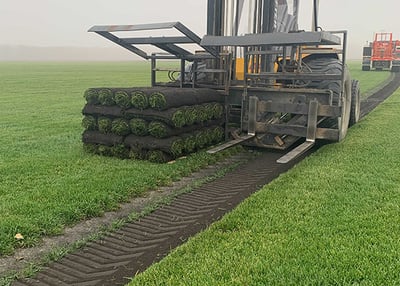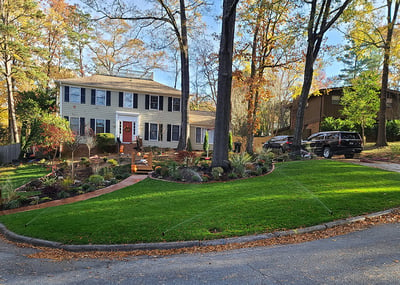

Fresh from the field, here are Super-Sod's December lawn tips for Bermuda, Centipede, and Zoysia lawns in the Southeast. There's not much for you to do this month, except raking. That doesn't mean you can stop reading - skim through to be reminded what not to do for warm season lawns when they're dormant.
🍂 Remove leaves from your lawn to prevent suffocation and diseases, even from dormant lawns. Rake or blow them into your beds and natural areas to use them as mulch rather than bagging them. Leaves are also a good addition to the compost pile. Read more about leaves as mulch and compost in Using Fall Leaves in the Garden.
Transitioning to Dormancy
With the frigid November temperatures in most areas of the Southeast, your warm season lawn will probably be dormant and tan-colored (light brown). If you live on the warmer coastal plain, your lawn may still be in the transition phase of going dormant (partially green and tan).
This Zoysia lawn above (in the header picture) is no longer fully green and lush because it is transitioning into dormancy. After another couple of frosts, this partially green and tan lawn will be fully dormant and a more uniform tan color. Everything is A-OK. It's just going to sleep.
Fertilizing Tips for Warm Season Lawns
- Do not fertilize or aerate warm-season lawns in autumn; wait until spring. We'll give you the go-ahead at that time.
- Resist "weed and feed" and "winterizer" marketing. Weed and feed pre-emergent combos are not effective at reducing weeds this time of year and winterizers usually contain high nitrogen.
- To emphasize: your lawn is going dormant, so don't apply a product with high nitrogen. Why not? Nitrogen's job is to promote fresh, green growth. When your lawn is going dormant, you don't want tender, new growth when there are frosty temperatures lurking. That new growth will get zapped by the frost, causing your lawn to struggle. Let it go to sleep like it wants to this time of year.
Weeding Tips for Warm Season Lawns
- Post-emergent herbicides for weeds you can see now in warm season lawns are tricky this time of year. If your lawn is not fully dormant, post-emergents can cause damage during the transition times in fall and spring.
👍 Rules of thumb:
- If you see any green in your lawn, consider holding off applying a post-emergent. Instead, choose mowing and hand weeding to protect the health of your lawn. If you live in a colder region and your warm season lawn is truly dormant and all tan-colored, then it's probably safe to apply a post-emergent herbicide.
- If your lawn is good and fully dormant, applying post-emergent is still weather-dependent. Most post emergents work best above 65 degrees so you should time application around weeks that are above 65 degrees. Read the label and follow the instructions.
- Mowing a dormant lawn is not a silly thing to do! In fact, if you didn't apply pre-emergent herbicide earlier in the fall, it's one of the best solutions you have for combating winter weeds. Mowing in winter is a smart way to suppress weeds because it cuts off flower/seed heads and that stops weeds from making more weeds, thus breaking the life cycle. If you have bad winter weeds, mow on a weekly routine and don't let the weeds get ahead of you.
- The window for applying pre-emergent herbicide has closed for the autumn. The next window will open in February when the Forsythia bushes flower - we'll send out an email alert at that time. Sign up for Lawn Coach and we'll ship you pre-emergent when it's time.
- Mulch is a time-tested trick for suppressing weeds in flower beds. Spread bark or pine straw 2-4" thick and keep it 1-2" away from touching the trunks or stems of your plants. Rake/blow leaves off your lawn and into your beds and natural areas rather than bagging them.
- Hand weeding is cheap! Save your money for Christmas presents and pull weeds by hand instead of spraying.
Mowing Tips for Warm Season Lawns
- Continue to mow your warm season lawn at the recommended height until it goes dormant, if it hasn't done so already.
- Don't leave your warm season lawn at a tall height for the winter; keep it at your regular cut height for your type of lawn.
- After your last mowing "winterize" your mower by cleaning off plant debris, draining gas so it doesn't sit with stale gas all winter, and take the time to sharpen or replace your mower blades. Now is a good time to go ahead and take care of the blades so your mower is prepped for spring mowing.
Come back next month for January Lawn Tips for Warm Season lawns!
If you have a Tall Fescue lawn (the best cool season lawn for the Southeast), here are your lawn tips for December.
Are you new here? Please subscribe to our emails to get this information in your inbox every month.






